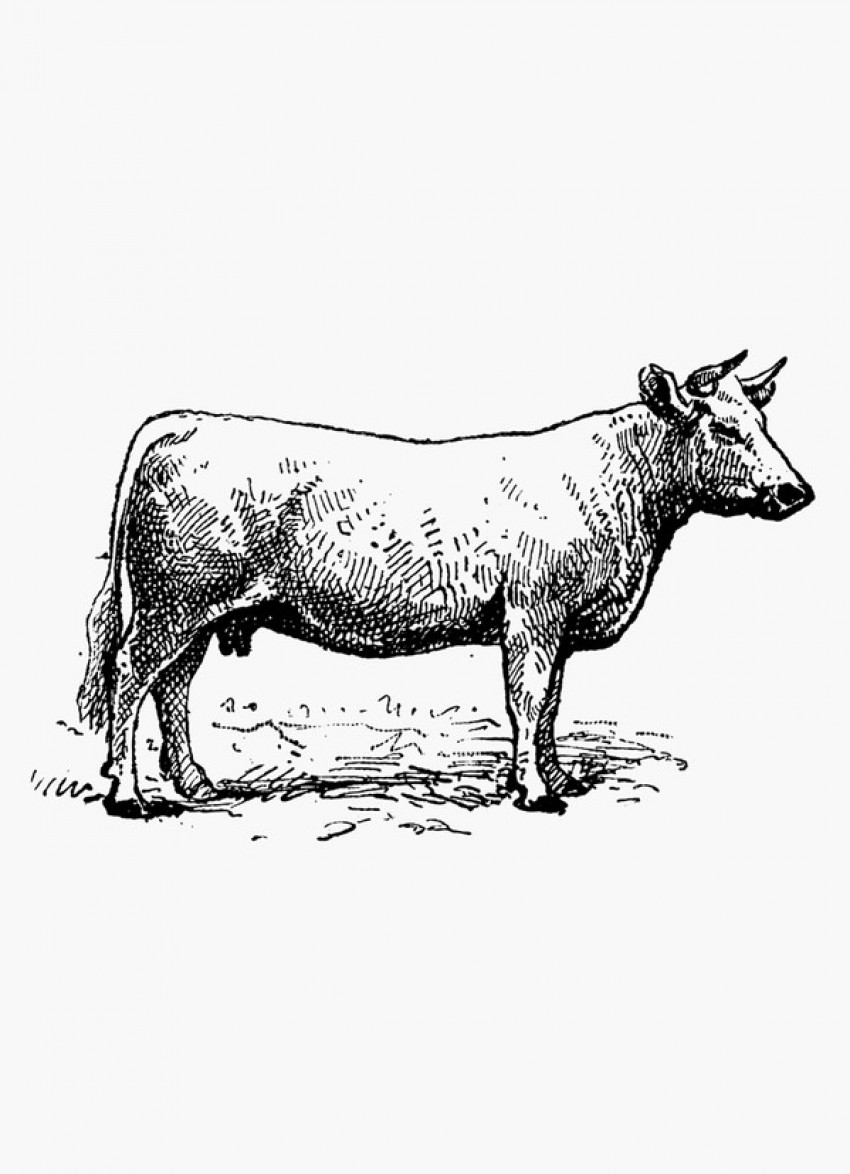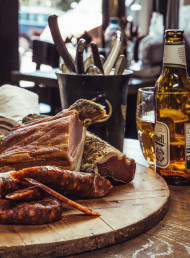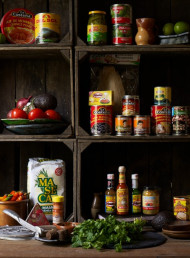A guide to meat: beef

A handy guide to meat cuts and simple cooking techniques.
SLOW COOKING CUTS
Short Ribs: the small rack of ribs from the flank. They can be cut long, shorter and stockier, or butterflied. Tender, meaty and versatile. Marinate and grill over charcoal, poach for a traditional Bollito Misto, or braise long and slow.
Tripe: the stomach lining from the first three stomachs of the cow. ‘Honeycomb’ tripe from the second stomach is the most popular. ‘Book’ tripe from the third stomach is the most delicate taking less cooking. Usually sold bleached and blanched, pale and creamy coloured, ready for use. Seasoning and slow cooking is the key. Stew tripe slowly in tomatoes and onions, use in a gratin, or crumb and deep fry it.
Oxtail: an old favourite for oxtail stew or soup. Long cooking is required so the meat falls from the bone. Oxtail braises exceptionally well due to the ratio of bone, fat and connective tissue, yielding superb flavour and texture.
Cheek: the meaty cheeks of the beast. Often ignored, this inexpensive cut offers exquisite flavour and texture. Similar to oxtail, some patient trimming and slow cooking are needed. Ideal for a fragrant, rich Carbonnade cooked with onions and dark beer, Chilli con Carne, or beef cheek, olive and red onion pies.
Brisket: from the ribs around the breastbone. Great for adding flavour to soups, it is always included in pot-au-feu. Famous in Texas cooked slowly in a charcoal smoker using Hickory or Mesquite. Equally delicious braised, pot-roasted, and barbequed. An excellent cut for brining and salting.
Chuck: Inexpensive and flavoursome. Responds to moist cooking methods so braise with good stock, wine and aromatic herbs. Great for Cornish pasties, steak and kidney hotpot, or minced for Bolognese. Chuck contains plenty of collagen, which melts during cooking adding extra flavour.
Shin: commonly called gravy beef and sold as a boned piece, cut into cubes, or as slices across the bone from the foreleg. One of the best cuts for long, slow cooking due to its gelatinous qualities, adding a velvety texture to the gravy. See recipe for ‘Braised Shin of Beef with Lemongrass and Coconut’
Thick flank: from the lower thigh just above the leg, you will buy this as braising steak or as a whole piece tied with string for roasting. Braising steak makes a good beef curry, or steak and onions in Guinness. Use plenty of liquid to keep both cuts moist and tender. A whole piece is best pot-roasted for two to three hours – a slow cooker is ideal.
Flank skirt: the diaphragm muscle between the ribs and hip. Lean, with long muscle fibres, and full-flavoured. Great fried á la minute and sliced across the muscle fibres, or stuffed and slowly braised to make beef olives, steak and kidney pudding, or fajitas.
Silverside: from the lower muscle of the rump, this cut has worked hard so long, slow cooking is ideal. It’s the classic Kiwi corned beef, brined and boiled with peppercorns and bay. The layer of fat is essential for keeping the meat moist. Also good pot-roasted in a pressure cooker with extra fat and aromatics.
Blade: from the shoulder. Can be tough but if handled well, surprisingly tender. Good for slow roasting (Bolar Roast) with or without the bone. Under Blade is best for braising. Top blade is more tender so suitable to pan fry. Look for marbled meat, with a strip of streaky connective tissue running down the centre of the steak.
ROASTING CUTS
Prime Rib: the cut for serious beef eaters, this comes from the back of the beast and contains the rib or scotch fillet. With fat and bone for flavour and moisture, good marbling in the fillet; and when aged, it’s the best choice for roasting rare. Also called Côte de boeuf, or French-style with the bones trimmed ‘rack of lamb’ fashion.
Wing Rib: the cut containing the last three ribs at the front of the sirloin. A squat roast, lean at the core with good fat to keep the meat tender and flavourful, this is the traditional English roast beef. If the rib bones are trimmed it is known as a standing rib roast. Sear and cook slowly to serve medium rare after resting.
T-Bone: from the lower, middle portion of the back, it includes the eye fillet and sirloin divided by a T-shaped bone. A big steak with lean marbled flesh and good fat. Best when aged, grill to rare, medium-rare.
Topside: Slow roast, braise or pot roast with vegetables and a little stock. Serve medium-rare sliced thinly. Great for cold roast beef sandwiches, and for making traditional Italian ‘bresaola’ (air-dried salted beef).
FAST COOKING CUTS
Rib eye: also known as scotch fillet, cut from the prime rib. Tender for pan-frying, barbecuing or grilling steaks rare to medium-rare. A fine piece of meat roasted as a whole juicy fillet too.
Fillet: also known as eye-fillet, tenderloin, undercut or fillet mignon when cut to a small, choice, round steak. Exquisitely tender, this piece of beef is highly prized though has less flavour than some other cuts. It’s very lean so dries out easily, serve as rare as possible. Frying, grilling, flash roasting or raw are the best options. Ideal for carpaccio, steak tartare, Boeuf en crôute, cold beef salads, or cooked whole and sliced with a classic shallot and red wine jus.
Rump: a cheaper cut as it’s a bit chewier but still tasty and versatile. The meat is better for aging or marinating and juicier if the marbling is even. Cut the steaks about 3-4 cm thick and cook rare to medium-rare. Ideal for steak and chips and stunning with a mustard or blue cheese sauce. Also good for Stroganoff, hamburger patties and casseroles.
Sirloin: also known as Porterhouse. From the lower middle of the back, a whole sirloin includes the fillet or tenderloin. Roast it rare on the bone in its entirety; or de-boned, pan-fry, grill or sear as steaks. This is top quality beef ideal for making Boeuf Bourguignon, or slicing paper thin for beef carpaccio. It is also sliced thinly for schnitzel.
Liver: calf or veal liver is tender and delicate. Ox liver can be overpowering so soak in milk before cooking. Remove the membrane prior to cooking otherwise it will curl up. Liver and bacon has long been a favourite but try slicing thinly across the whole piece then flash fry or grill with plenty of garlic, freshly squeezed lemon juice and parsley.
latest issue:
Issue #120
As the days become shorter, and the nights cooler, the latest issue is perfectly timed to deliver delicious autumn dishes. From recipes using fresh seasonal produce such as feijoas and apples, to spectacular soothing soups and super-quick after-work meals in our Food Fast section, we’ve got you covered. With Easter on the horizon, we feature recipes that will see you through breakfast, lunch and dinner over a leisurely weekend holiday, and whip up chocolatey baking treats sure to please. We round up delicious dinners for two and showcase a hot new Korean cookbook before heading south to Dunedin to check out all that’s new in food and dining.The latest issue of dish is on sale NOW at all good bookstores and supermarkets – don’t miss it!





